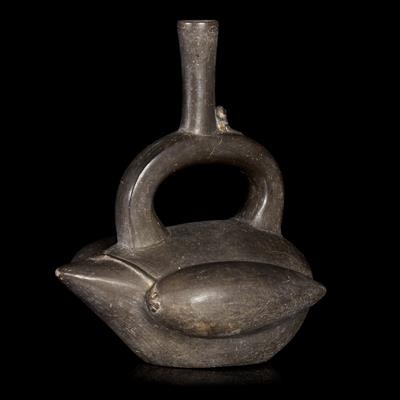Flask
Download media
Object number06191
TitleFlask
CreatorChimu
DescriptionThis earthenware water flask is a remarkable example of pottery from the north coast of present-day Peru. It was made sometime between 1100-1400 by the Chimú, one of a series of sophisticated civilisations that flourished in South America, who were ultimately defeated and absorbed by the Incas during the mid-15th century.
Chimú pottery is very distinctive, with its charcoal black colour and polished, smooth surface. The colour is thought to have been made by limiting the oxygen supply during firing. The smoke and soot darkened the pottery, which was burnished to a shine once it had cooled. Chimú pottery was usually mass-produced using moulds and is quite sculptural – almost modern-looking – in shape and regularity.
Pottery vessels were an everyday essential, used for cooking, storing food and carrying water. Easily broken, it meant that local potters were always busy. Styles evolved through function, decorations were influenced by traditions and symbolism.
For the Chimú, inspiration often came from the sea. Look at this intriguingly shaped flask: is it a bird, or perhaps a boat? It has a stirrup spout, named because it is shaped like a stirrup on a horse’s saddle. This form was extremely popular on Peru’s north coast for more than 2,500 years. Why did they choose this unusual shape? One theory is that the double-branch with a single-spout could reduce evaporation of the liquid inside when the weather was hot. Or perhaps it was just easier to carry, using the stirrup as a handle! There is also a tiny monkey sitting just next to the neck of the spout; monkeys are often found decorating this type of earthenware.
Production placeS. America Peru North Coast
Production date 1100 - 1400
Object nameFlask
MaterialEarthenware
Dimensions
whole Length: 200 mm
body Diameter: 145mm mm
whole Height: 220 mm
body Diameter: 145mm mm
whole Height: 220 mm

